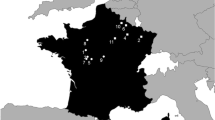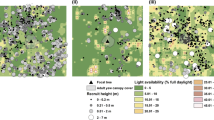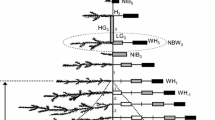Abstract
Composition, structure, and species-specific patterns of recruitment and growth were characterized in two yellow birch (Betula alleghaniensis Britt.)–conifer stands in Quebec, Canada, to improve our understanding of the dynamics of these complex ecosystems. The mixture of mid- and shade-tolerant species in the canopy, the inverse J-shape stem diameter distribution, and the age distribution were indicative that the two stands were in a late-successional stage. Recruitment of mid-tolerant species above 1.3 m in height appeared to be periodic and synchronized with historical spruce budworm (Choristoneura fumiferana Clem.) outbreaks, while the coniferous component of these mixedwood stands recruited continuously. Results suggest that recruitment of yellow birch and red maple (Acer rubrum L.) requires disturbances of a certain intensity that affect at least 25 % of the forest cover. In contrast, balsam fir (Abies balsamea (L.) Mill.) and red spruce (Picea rubens Sarg.) can recruit under the canopy without relying on moderate or large canopy disturbances. Results suggest that the historical disturbance regime, and differences in shade tolerance between species, largely govern the contemporary composition of these stands. This study improves the comprehension of mechanisms that regulate the dynamics of yellow birch-conifer stands and will be useful for the subsequent elaboration of forest management strategies.




Similar content being viewed by others
References
Abrams MD (1998) The red maple paradox. Bioscience 48:355–364
Abrams MD, Downs JA (1990) Successional replacement of old-growth white oak by mixed mesophytic hardwoods in southwestern Pennsylvania. Can J For Res 20:1864–1870
Abrams MD, Orwig DA, DeMeo TE (1995) Dendroecological analysis of successional dynamics for a presettlement-origin white pine-mixed oak forest in the southern Appalachians, USA. J Ecol 83:123–133
Archambault L, Morissette J, Bernier-Cardou M (1997) Forest succession following a forest fire in a mixed forest of Bas-Saint-Laurent, Quebec. For Chron 73:702–710
Archambault L, Morissette M, Bernier-Cardou M (1998) Forest succession over a 20-year period following clearcutting in balsam fir–yellow birch ecosystems of eastern Québec, Canada. For Ecol Manag 102:61–74
Archambault L, Bégin J, Delisle C, Fortin M (2003) Dynamique forestière après coupe partielle dans la forêt expérimentale du Lac Édouard, Parc de la Mauricie, Québec. For Chron 79:672–684
Archambault L, Delisle C, Larocque GR, Sirois L, Belleau P (2006) Fifty years of forest dynamics following diameter-limit cuttings in balsam fir: yellow birch stands of the Lower St. Lawrence region. Quebec Can J For Res 36:2745–2755
Bakuzis EV, Hansen HL (1965) Balsam fir—a monographic review. University of Minnesota Press, Minneapolis
Bergeron Y, Leduc A (1998) Relationships between change in fire frequency and mortality due to spruce budworm outbreak in the southeastern Canadian boreal forest. J Veg Sci 9:493–500
Bergeron Y, Leduc A, Joyal C, Morin H (1995) Balsam fir mortality following the last spruce budworm outbreak in northwestern Quebec. Can J For Res 25:1375–1384
Black BA, Abrams MD (2003) Use of boundary-line growth patterns as a basis for dendroecological release criteria. Ecol Appl 13:1733–1749
Blum BM (1990) Picea rubens Sarg. (red spruce). In: Burns RM, Honkala BH (eds) Silvics of North America. Conifers, vol 1. USDA Forest Service Agricultural Handbook 654. USDA Forest Service, Washington, DC, pp 250–259
Bouchard M, Kneeshaw DD, Bergeron Y (2005) Mortality and stand renewal patterns following the last spruce budworm outbreak in mixed forests of western Quebec. For Ecol Manag 204:297–313
Bouchard M, Kneeshaw DD, Bergeron Y (2006) Tree recruitment pulses and long-term species coexistence in mixed forests of western Québec. Ecoscience 13:82–88
Bouchard M, Kneeshaw DD, Messier C (2007) Forest dynamics following spruce bubworm outbreaks in the northern and southern mixedwoods of central Québec. Can J For Res 37:763–772
Boucher Y, Arseneault D, Sirois L, Blais L (2009) Logging pattern and landscape changes over the last century at the boreal and deciduous forest transition in Eastern Canada. Landsc Ecol 24:171–184
Burton PJ, Balisky AC, Coward LP, Cumming SG, Kneeshaw DD (1992) The value of managing for biodiversity. For Chron 68:225–237
Coté L, Brown S, Paré D, Fyles J, Bauhus J (2000) Dynamics of carbon and nitrogen mineralization in relation to stand type, stand age and soil texture in the boreal mixedwood. Soil Biol Biochem 32:1079–1090
Cottam G, Curtis JT (1956) The use of distance measures in physiological sampling. Ecology 37(3):451–460
De Luis M, Raventos J, Cortina J, Moro MJ, Bellot J (1998) Assessing components of a competition index to predict growth in an even-aged Pinus nigra stand. New For 15:223–242
Dibble AC, Brissette JC, Hunter ML Jr (1999) Putting community data to work: some understory plants indicate red spruce regeneration habitat. For Ecol Manag 114:275–291
Dubois J, Ruel JC, Elie JG, Archambault L (2006) Dynamique et estimation du rendement des strates de retour après coupe totale dans la sapinière à bouleau jaune. For Chron 82:675–689
Duchesne L, Ouimet R (2008) Population dynamics of tree species in southern Québec, Canada: 1970–2005. For Ecol Manag 255:3001–3012
Duchesne L, Ouimet R, Houle D (2002) Basal area growth of sugar maple in relation to acid deposition, stand health, and soil nutrients. J Environ Qual 31:1676–1683
Duchesne L, Ouimet R, Morneau C (2003) Assessment of sugar maple health based on basal area growth pattern. Can J For Res 33:2074–2080
Dumais D, Prévost M (2007) Management for red spruce conservation in Québec: the importance of some physiological and ecological characteristics—a review. For Chron 83:378–392
Fei S, Steiner KC (2007) Evidence for increasing red maple abundance in eastern United States. For Sci 53:473–477
Fei S, Steiner KC (2009) Rapid capture of growing space by red maple. Can J For Res 39:1444–1452
Fortin M, Bégin J, Bélanger L (2003) Évolution de la structure diamétrale et de la composition des peuplements mixtes de sapin baumier et d’épinette rouge de la forêt primitive après une coupe à diamètre limite sur l’Aire d’observation de la rivière Ouareau. Can J For Res 33:691–704
Frank RM (1990) Abies balsamea (L.) Mill. (balsam fir). In: Burns RM, Honkala BH (eds) Silvics of North America. Conifers, vol 1. USDA Forest Service Agricultural Handbook 654. USDA Forest Service, Washington, DC, pp 26–35
Girard C, Darveau M, Savard JP, Huot J (2004) Are temperate mixedwood forests perceived by birds as a distinct forest type? Can J For Res 34:1875–1907
Gutiérrez AG, Armesto JJ, Aravena JC (2004) Disturbance and regeneration dynamics of an old-growth North Patagonian rain forest in Chiloé Island, Chile. J Ecol 92:598–608
Hébert R (2003) Are clearcuts appropriate for the mixed forest of Québec? For Chron 79:664–671
Henry JD, Swan JMA (1974) Reconstructing forest history from live and dead plant material—an approach to the study of forest succession in southwest New Hampshire. Ecology 55:772–783
Hibbs DE (1982) Gap dynamics in a hemlock–hardwood forest. Can J For Res 12:522–527
Holmes RL (1996) Dendrochronology program library, version 2.0. Laboratory of Tree-Ring Research, University of Arizona, Tucson
Holmes MJ, Reed DD (1991) Competition indices for mixed species northern hardwoods. For Sci 37:1338–1349
Johnson EA (1992) Fire and vegetation dynamics: studies from the North American boreal forest. Cambridge University Press, New York
Johnson KN, Agee J, Beschta R, Dale V, Hardesty L, Long J, Nielsen L, Noon B, Sedjo R, Shannon M, Trosper R, Wilkinson C, Wondolleck J (1999) Sustaining the people’s lands: recommendations for stewardship of the national forests and grasslands into the next century. J For 97:6–12
Kneeshaw DD, Bergeron Y (1998) Canopy gap characteristics and tree replacement in the southern boreal forest. Ecology 79:783–794
Kneeshaw DD, Prévost M (2007) Natural canopy gap disturbances and their role in maintaining mixed-species forest of central Quebec, Canada. Can J For Res 37:1534–1544
Krankina ON, Harmon ME, Griazkin AV (1999) Nutrient stores and dynamics of woody detritus in a boreal forest: modeling potential implications at the stand level. Can J For Res 29:20–32
Laflèche V, Ruel JC, Archambault L (2000) Évaluation de la coupe avec protection de la régénération et des sols comme méthode de régénération de peuplements mélangés du domaine bioclimatique de la sapinière à bouleau jaune de l’est du Québec, Canada. For Chron 76:653–663
Lorimer CG (1983) Test of age dependent competition indices for individual trees in natural hardwood stands. For Ecol Manag 6:343–360
Lorimer CG (1985) Methodological consideration in the analysis of forest disturbance history. Can J For Res 15:200–213
Lorimer CG, Frelich LE (1989) A methodology for estimating canopy disturbance frequency and intensity in dense temperate forests. Can J For Res 19:651–663
Luckert MK, Williamson T (2005) Should sustained yield be part of sustainable forest management? Can J For Res 35:356–364
Mailly D, Turbis S, Pothier D (2003) Predicting basal area increment in a spatially explicit, individual tree model: a test of competition measures with black spruce. Can J For Res 33:435–443
Morin H (1994) Dynamics of balsam fir forests in relation to spruce budworm outbreaks in the Boreal Zone of Quebec. Can J For Res 24:730–741
Nyland RD (2002) Silviculture: concept and applications, 2nd edn. McGraw-Hill, New York
Oliver CD, Stephens EP (1977) Reconstruction of a mixed-species forest in central New England. Ecology 58:562–572
Parent D, Fortin C (2003) Ressources et industrie forestières, portrait statistique, édition 2002. Ministère des Ressources naturelles et Faune, Québec. ISBN 2-550-38776-7
Perala DA, Alm AA (1990) Reproductive ecology of birch: a review. For Ecol Manag 32:1–38
Pomminville P, Déry S, Bélanger L (1999) Dynamique de la sapinière à bouleau jaune de l’est après une épidémie de tordeuse des bourgeons de l’épinette. For Chron 75:515–534
Prévost M (2008) Effect of cutting intensity on microenvironmental conditions and regeneration dynamics in yellow birch–conifer stands. Can J For Res 38:317–330
Prévost M, Roy V, Raymond P (2003) Sylviculture et régénération des forêts mixtes du Québec (Canada): une approche qui respecte la dynamique naturelle des peuplements (Note de recherche forestière no. 125). Ministère des Ressources naturelles, de la Faune et des Parcs, Direction de la recherche forestière, Québec
Prévost M, Raymond P, Lussier JM (2010) Regeneration dynamics after patch cutting and scarification in yellow birch–conifer stands. Can J For Res 40:357–369
Robitaille A, Saucier JP (1998) Paysages régionaux du Québec méridional. Ministère des Ressources naturelles du Québec, Direction de la gestion des stocks forestiers et Direction des relations publiques, Québec
SAS Institute (2002) SAS version 9. SAS Institute, Cary
Saucier JP, Grondin P, Robitaille A, Gosselin J, Morneau C, Richard PJH, Brisson J, Sirois L, Leduc A, Morin H, Thiffault É, Gauthier S, Lavoie C, Payette S (eds) (2009) In: Éditions Multimonde Ordre des ingénieurs forestiers du Québec (ed) Écologie forestière. Manuel de foresterie, 2nd edn. Éditions MultiMondes, Québec, pp 165–315
Tift BD, Fajvan MA (1999) Red maple dynamics in Appalachian hardwood stands in west Virginia. Can J For Res 29:157–165
Walters RS, Yawney HW (1990) Acer rubrum L. (red maple). In: Burns RM, Honkala BH (eds) Silvics of North America. Conifers, vol 1. USDA Forest Service Agricultural Handbook 654. USDA Forest Service, Washington, DC, pp 60–69
Winget CH, Kozlowski TT (1965) Yellow birch germination and seedling growth. For Sci 11:386–392
Yamaguchi DK (1991) A simple method for cross-dating increment cores from living trees. Can J For Res 21:414–416
Acknowledgments
We would like to thank Patricia Raymond, Robert Jobidon, and two anonymous reviewers for revising an earlier version of the manuscript. We would also like to thank Maurice Gagnon for performing the core sampling and tree ring measurements in the laboratory. We finally acknowledge Jean-Pierre Lapointe, Carlo Gros-Louis, Julie Forgues, Daniel Guimond, Serge Williams, Éric Saulnier, and many summer students for field assistance over the years.
Author information
Authors and Affiliations
Corresponding author
About this article
Cite this article
Duchesne, L., Prévost, M. Canopy disturbance and intertree competition: implications for tree growth and recruitment in two yellow birch–conifer stands in Quebec, Canada. J For Res 18, 168–178 (2013). https://doi.org/10.1007/s10310-012-0338-1
Received:
Accepted:
Published:
Issue Date:
DOI: https://doi.org/10.1007/s10310-012-0338-1




